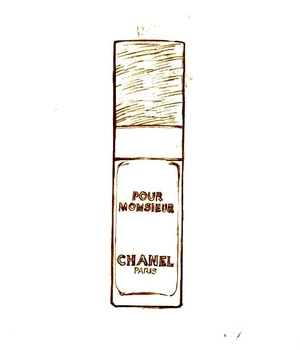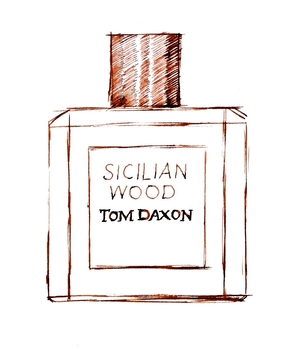Tagged With ‘Henri Robert’
Chanel
Pour Monsieur
7 July, 2015
 I’ve loved Pour Monsieur for decades now, so it was a bit of a surprise when I realised that I hadn’t reviewed it up till now. But actually I think that tells you something about the fragrance itself, which is so discreet that it’s all too easy to overlook – and that’s a real shame, because it’s a wonderful thing.
I’ve loved Pour Monsieur for decades now, so it was a bit of a surprise when I realised that I hadn’t reviewed it up till now. But actually I think that tells you something about the fragrance itself, which is so discreet that it’s all too easy to overlook – and that’s a real shame, because it’s a wonderful thing.
Pour Monsieur smells softly spicy when you first spray it on, but soon you also start smelling its mossy, herbaceous base. The spiciness comes partly from cardamom, and the woodiness is a mixture of oakmoss (actually a type of fragrant lichen) with tiny amounts of cedarwood, resinous labdanum (a kind of cistus) and earthy vetiver.
Chanel’s first modern men’s fragrance, it was conjured up by the perfumer Henri Robert and launched in 1955. Robert, who was born in 1899 and died in 1987, took over at Chanel after the retirement of the legendary Ernest Beaux, and went on to launch Chanel No19 in 1970 and Cristalle in 1974.
Pour Monsieur is one of the best examples of the perfume style or ‘family’ known as chypre, which derives from the French for Cyprus (the island rather than the tree), presumably inspired by the scent of Mediterranean herbs and shrubs baking in the sun. The basic combination – first popularised by François Coty in a 1917 perfume of the same name – combines bergamot, oakmoss and labdanum.
There have been endless variations on the theme since, but few of them match Pour Monsieur for sheer class; even its packaging is beautifully cool. Though it’s not an expensive perfume, it is redolent of luxury in its quiet complexity, like the deceptively simple face of a Patek Philippe watch. This is insider luxury, if you like, which is all about discretion and restraint rather than ostentation and excess.
The upside – in a perfume or a Patek Philippe – is that not everyone will recognise what you’re wearing. And while Pour Monsieur lasts a long time on the skin, it’s one of those fragrances that doesn’t carry far, so if you’re looking to impress it probably isn’t for you. But if wearing something wonderful makes you feel more self-confident and assured, then I can think of few better perfumes to buy.
Tom Daxon
Sicilian Wood
11 January, 2015
 I had high hopes of Sicilian Wood. Tom Daxon launched his perfume business in March 2013 at the age of 25, and has quickly gained a lot of fans. I’m not surprised, as he looks like a nice chap and he should know his stuff: his mother, Dale Daxon Bowers, was trained as a chemist and worked for Mary Quant cosmetics before becoming creative director of Molton Brown, so you could say that Tom grew up in the fragrance business.
I had high hopes of Sicilian Wood. Tom Daxon launched his perfume business in March 2013 at the age of 25, and has quickly gained a lot of fans. I’m not surprised, as he looks like a nice chap and he should know his stuff: his mother, Dale Daxon Bowers, was trained as a chemist and worked for Mary Quant cosmetics before becoming creative director of Molton Brown, so you could say that Tom grew up in the fragrance business.
He’s started out with a small range of nine different perfumes, and as you’d hope given his background they’re outstandingly well designed and packaged, with sharp typefaces, smart faceted bottles and attractive boxes cleverly secured with criss-crossing black ribbons.
So far so good. The only trouble is, try as I might I just can’t get to like the perfume inside.
Daxon compares Sicilian Wood with ‘a citrus grove warming in the sun… [with] an effervescent, hyper-real citrus top note [that] settles into a base of seductive woods.’ He’s also described it as ‘a budget-less woody citrus [that] will prove a revelation to anyone left underwhelmed by all the bland versions out there.’
I certainly get the citrus, and the warmth, which emerges from a mix of (among other things) cardamom, guaiac wood, jasmine, cedar and sandalwood. But Sicilian Wood also has to me an unsettling, slightly sickly, somehow faintly chemical smell, which it shares with so many men’s fragrances on the market (especially so-called ‘sports’ scents) that I call it cheapone: the very opposite of ‘budget-less’, in other words.
Whatever it is, it spoils this perfume for me, which is a shame, as I’d really like to like it, not least because it was created by Carla Chabert and her father Jacques, who was once assistant to the perfumer Henri Robert at Chanel, and is said to have had a hand in Chanel’s classic Cristalle. Time to explore some of the other perfumes in the range.
Hermès
Equipage
14 July, 2014
 Equipage is a perfume I hadn’t smelled for years. I had a bottle long ago, but when it ran out I never got round to replacing it. Actually I’d forgotten how good it smells, so I’m delighted to have it back. It’s as timeless and well made as a piece of Hermès saddlery, and it even has something of the same comforting, leathery smell.
Equipage is a perfume I hadn’t smelled for years. I had a bottle long ago, but when it ran out I never got round to replacing it. Actually I’d forgotten how good it smells, so I’m delighted to have it back. It’s as timeless and well made as a piece of Hermès saddlery, and it even has something of the same comforting, leathery smell.
The first Hermès perfume to be aimed at men, Equipage was created by Guy Robert, one of the leading perfumers of his generation. You could say that Robert had perfume in his blood. He learned his trade in Grasse, once the world capital of perfumery and still an important production centre today. His uncle, Henri Robert, succeeded Ernest Beaux as perfumer-in-chief at Chanel, where he created No.19 and Pour Monsieur.
Equipage shares much of its character with Pour Monsieur, smelling effortlessly grown-up, discreet and rather conservative. The funniest comment I’ve seen online is that it ‘makes you smell ten years older. Richer, maybe; but older’, and I think that’s right, but now I’m older myself it’s nice to at least smell rich.
For a men’s perfume it has rather more floral ingredients than one might expect, including lily of the valley, jasmine and carnation, but they’re so subtly blended together that you’d never know. The flowers give it a little sweetness, but that’s balanced by the spicy, clove-scented edge of carnation. Equipage also contains a lot of orange, in the form of bergamot, squeezed from the peel of the Sicilian bergamot orange, Citrus bergamia, which is also used to flavour Earl Grey tea.
But that’s not all. This rich and complex fragrance also includes oakmoss (or a synthetic equivalent), which is actually a type of lichen that smells like a forest after rain; as it happens oakmoss also features in Pour Monsieur and Chanel No19. You might also be able to smell a touch of patchouli, that favourite 1970s fragrance, and perhaps a little Badedas-like pine – another forest touch.
There’s much, much more, which makes Equipage worth returning to again and again. It may not be the most avant-garde of fragrances, but if you want something reassuringly luxurious, it’s up there with the best.